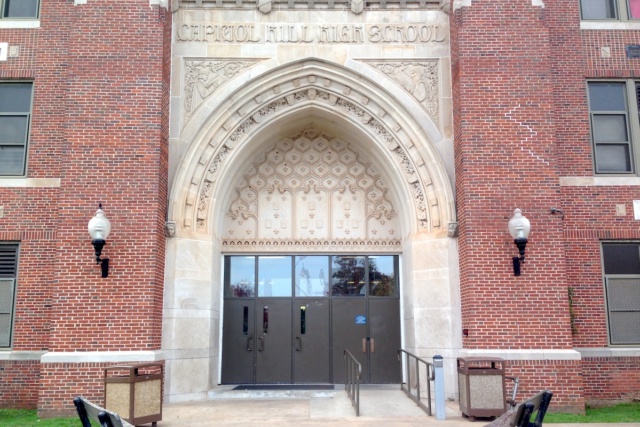State Superintendent Joy Hofmeister spoke recently at a community meeting hosted by the Oklahoma State Department of Education. After hearing what she had to say, it was easy to believe that Oklahoma schools are ready to move beyond the use of unreliable and invalid test scores (such as the A-F School report card) to intimidate educators into overcoming the educational legacies of poverty.
The audience made it obvious Nov. 14 at Capitol Hill that they have had enough of bubble-in accountability, and the Hofmeister administration is listening. She previewed its new effort to expand college-readiness instruction and equal access to challenging and meaningful courses. Given federal pressure, the administration will almost certainly have to incorporate some test-driven growth measures, but its intent was made clear: As long as school systems are convinced that those estimates won’t be used to punish unfairly, the questionable statistics’ downsides can be minimized.
Superintendent Hofmeister’s most important message was that a completely different, thoughtful and collaborative mindset has replaced the top-down and punitive accountability obsession of the last 15 years. To that end, her department carefully seeks to employ research-based methods that address each individual flaw of grading schools.
Meanwhile, back at the Fordham Institute …
About a week before Hofmeister’s appearance, The Oklahoman published a guest editorial from the Thomas B. Fordham Institute’s Mike Petrilli and Brandon Wright. In it, the authors outline a plan to do the seemingly impossible: Fordham would make the discredited A-F grade card guesstimates even more destructive than at present.
It’s not like Fordham has researched Oklahoma’s grade cards and the options for improvement created by the new Every Student Succeeds Act (ESSA) and then contemplated a better system for Oklahoma. Quite the opposite: Fordham has championed its own national boilerplate matrix, which shifts the emphasis from poor students to high-performing, mostly affluent kids. (When incorporating Fordham’s agenda into law, Oklahoma gets one out of four stars.) Fordham’s methodologies would restart the failed NCLB attempt to punish schools that inevitably miss impossible growth targets for poor kids while simultaneously rewarding suburban schools and charters.
There is a method, born of national edu-politics, for Fordham’s attempt to make the Oklahoma brand of No Child Left Behind madness more unfair to urban schools. As the liberal, neoliberal and conservative corporate-reform coalition collapses, the conservative think tank is abandoning the pretense that accountability-driven reform is a civil rights strategy. Instead, conservatives are going back to their first true love: the free market.
Make America Great Again, but for education
Fordham’s accountability model is basically Make America Great Again for the education world. It would roll back federal micromanaging and allow the upper half of our dynamic democracy to recreate a path to higher education and prosperity. Test-driven metrics would keep score in the stacked competition between charter schools (which can show students the exit when they don’t measure up) and traditional schools (which serve everyone who walks in the door). OKCPS neighborhood schools could easily become an alternative-school system that remediates the students charters wouldn’t serve, in turn freeing them and wealthy communities to provide the educations and dignity all families deserve.
It’s good that the Fordham approach would liberate some schools, allowing them to restore holistic, engaging college-readiness instruction, but the approach ignores the cognitive science that explains why its so-called “growth measures” would damage lower-skilled students. Of course all kids can gain from a meaningful curriculum and improve their scores on complex assessments (which are a backdoor effort to bring back Fordham’s other true love, Common Core), however, the progress of low-skilled students will always be slower. Since uniform growth targets are biased against poor schools, those schools will increase the pressure to impose worksheet-driven, cover-your-rear instruction in urban classrooms.
There used to be a name for Fordham’s model. It was called earned autonomy, but actually it was earned dignity. High-performing schools would be liberated and granted autonomy so they could offer a meaningful education to prepare middle and upper-middle class as well as high-performing charter students for the 21st century. Drill-and-kill along with bubble-in accountability (and No Excuses behaviorism) would be imposed on poor children of color.
To improve, students must be present
In contrast, the best part of Hofmeister’s new accountability framework are metrics for fighting chronic absenteeism. Students can’t grow academically if they are absent from school. Especially with highly mobile student populations, it is easy for disadvantaged kids to miss too many classes due to circumstances beyond their control, and today there are few mechanisms for helping them catch up. When I taught at Centennial H.S., a student transferred in or out of my class every day. A third of our students were chronically absent.
Tulsa Public Schools recently self-reported a most startling — and instructive — statistic about absenteeism. As early as Nov. 2, about a fifth of its students were already chronically absent. In such a situation, schools have two basic options: They can let the kids fail for the rest of the year, falling further and further behind until they, most likely, drop out. Or, they can do what Tulsa researchers recommend and invest in targeted interventions.
We can listen to Fordham’s competition-driven reformers and turn schooling into survival of the fittest. Or, we can work with the Hofmeister administration and use data to identify problems and devise solutions.
If we invest in early warning systems and employ mentors to conduct home visits, essentially helping students navigate through structural barriers to attending school, we can stop chronic truancy before it metastasizes. If we reach out to our most vulnerable kids before they fall hopelessly behind, who knows how many more of them will excel in college-readiness classes and higher education?






















